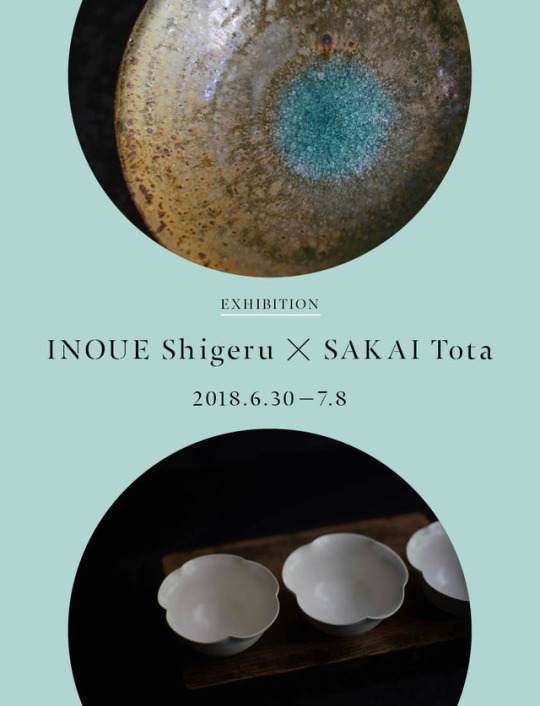#iremono
Photo

RESONANCE OF GROUND AND PEOPLE. Tiger eye brass ring Tiger eye brass ear cuff At Tanzawa Photo::: @namasayaio MASHU POPUP 〜Natural Stone〜 2022.12/08(thu)〜12/11(sun) 営業時間:::12:00〜20:00 12/11(sun)のみ〜19:00 在店時間:::15:00〜20:00 12/11(sun)のみ〜19:00 @iremono__ 桜新町 #MASHU #MASHUaccessory #MASHUjewelry #MASHUPOPUP #iremono #桜新町 #sakurashinmachi #サザエさん通り商店街 この商品は12/8〜12/11までの @iremono__ での MASHU POPUPにて販売中です。 (iremono) https://www.instagram.com/p/Cl-gEZUyMN3/?igshid=NGJjMDIxMWI=
0 notes
Photo

Utah calf / black rollwallet / iremono gamaguchi up 自然豊かなフランス・アルザス地方に居を構える1842年創業のタンナー、HAAS社で作られたロシアンカーフを思わせる菱形の型押しが特徴的なプレミアムレザー。 栗やミモザなどの植物を使ったタンニン鞣しで作られる< Utah calf(ユタカーフ)> は固めの質感が多い一般的な型押しと違い非常にしなやかで柔らかく何種類ものオイルが含まれているため通常のカーフと比べ耐水性にも優れた革となります。 #black #utahcalf #rollwallet #miniwallet #smallwallet #minimum #minimalistic #compact #leather #wallet #leatherwallet #gamaguchi #iremono #がま口 #がま口財布 #革 #財布 #革財布 #小銭入れ #名刺入れ #小さい財布 #ミニ財布 #二つ折り財布 #三つ折り財布 #薄い財布 #軽い財布 #身軽 #handy #otomahc #chamoto (Osaka) https://www.instagram.com/p/CgeEqY5PJVG/?igshid=NGJjMDIxMWI=
#black#utahcalf#rollwallet#miniwallet#smallwallet#minimum#minimalistic#compact#leather#wallet#leatherwallet#gamaguchi#iremono#がま口#がま口財布#革#財布#革財布#小銭入れ#名刺入れ#小さい財布#ミニ財布#二つ折り財布#三つ折り財布#薄い財布#軽い財布#身軽#handy#otomahc#chamoto
0 notes
Text
Kanji for 'question', 'ask', 'problem'
問 - mon/ tou/ toi/ ton
問題集 - mondaishuu - a collection of problems / a workbook - もんだいしゅう
学問 - gakumon - learning/ studies/ an academic discipline - がくもん
問う - tou - to ask/ to question - とう
問題 - mondai - a problem / a question / a matter - もんだい
疑問 - gimon - (a) doubt/ a problem/ (a) question - ぎもん
問い合わせ - toiawase - an inquiry - といあわせ
________________________
Kanji for 'sound', 'noise', 'speech sound', 'voice'
音 = in / on/ otonu
母音 - boin - a vowel - ぼいん
録音する - rokuonsuru - to record (sound) / to tape (audio) - ろくおんする
音 - oto - a sound / a noise/ a din/ a commotion - おと
音楽 - ongaku - music - おんがく
子音 - shiin - a consonant - しいん
本音 - honnu - one's real intention/ one's real motive - ほんぬ
______________
Kanji for 'before', 'front', 'former'
前 = zen / mae
名前 - namae - a name / one's name - なまえ
手前 - temae - this side - てまえ
前もって - maemotte - beforehand / in advance - まえもって
直前に - cyokuzenni - immediately (right, directly) before/ just before - ちょくぜんに
三日前 - mikkamae - Three days ago - みっかまえ
前回 - zenkai - last time - ぜんかい
________________________
Kanji for 'sea', 'ocean'
海 = umi / kai
海 - umi - the sea / an ocean - うみ
海岸 - kaigan - the seashore / the beach / the seaside - かいがん
日本海 - nihonkai - The Sea of Japan - にほんかい
海外 - kaigai - overseas (foreign) countries - かいがい
海草 - kaisou - seaweed / marine plants - かいそう
海へ行く - umiheiku - to go to the seaside - うみへいく
______________________
Kanji for 'villge', 'rural district'
村 = shin / mura
市町村 - shicyouson - cities / towns and villages - しちょうそん
村 - mura - a village / a hamlet - むら
漁村 - gyoson - a fishing village - ぎょそん
農村 - nouson - a farm(ing) village / an argicultural district - のうそん
村長 - sonchyou - a village chief - そんちょう
村民 - sonmin - a villager - そんみん
_______________________
Kanji for 'voice', 'sound'
声 = sei / shyou / koe / kowa
声 - koe - a voice/ a tone (of voice) / a cry/ a call/ a sound - こえ
笑い声 - waraigoe - laughter / a laughing voice - わらいごえ
名声 - meisei - fame / (a) reputation - めいせい
大声を出す - oogoe (w)o dasu - to raise one's voice / to shout - おおごえ を だす
小声 - kogoe - a low voice / a whisper - こごえ
声をかける - koe (w)o kakeru - to call out (to) /to hail /to say something - こえ を かける
_________________________
Kanji for 'like', 'be fond of', 'favourable', 'good', 'fine'
好 = kou / konomu / suku
大好き(だ)- daisuki(da) - to be very fond of / to have a great liking for - だいすきだ
好み - konomi - (a) liking / (a) taste / (a) preferance - このみ
格好 - kakkou - (a) shape / (a) form / a figure / appearance(s) - かっこう
格好(の)いい- kakkou (no) ii - attractive / nice-looking / nicely-shaped - かっこう(の)いい
好む - konomu - to like / to be fond (of) / to have a liking - このむ
好き - suki - (a) liking / (a) fondness / (a) love - すき
_________________
Kanji for "thing", "goods", "object"
物 = butsu / motsu / mono
果物 - kudamono - (a) fruit -くだもの
動物園 - doubutsuen - a zoo / zoological gardens - どうぶつえん
荷物 - nimotsu - a burden/ a load / baggage/ freight / goods - にもつ
入れ物 - iremono - a container/ a case - いれもの
忘れ物 - wasuremono - a thing left behind / a lost article - わすれもの
見物 - kenbutsu - sightseeing / a visit- けんぶつ
21 notes
·
View notes
Text
死の舞踏会 / Shi no Butoukai (Shimotsuki Haruka / Remlerose no Majo) romaji + traduction FR)
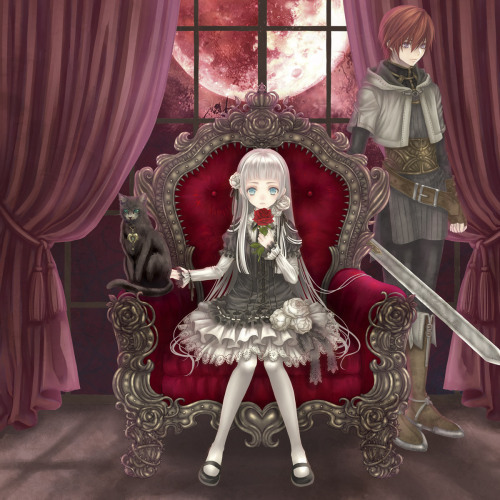
Titre : Shi no Butoukai (死の舞踏会)
Artiste: Shimotsuki Haruka ( 霜月はるか )
Album: Remlerose no Majo (レムルローズの魔女)
満ちる朱の月…集え我が愛し子よ…
Michiru aka no tsuki... Tsudoe waga shimobe yo...
En cette pleine lune rouge... Venez à moi, mes chers serviteurs...
Rem la marie, Fem la Malice.
Rem la mirya, Fem la mirya.
Wario la wise, Malice la wise.
Rem la torine, Rem la arie.
Hinare, nowrrie, vilte.
Rem la wizarre.
Rem la marie, Rem la arlie.
Rem la torrine arie.
Malice la fat lauwa, Fem le sarce Andalucia.
Nous sommes vos esclaves, vous êtes notre sorcière.
Nous sommes vos yeux, entièrement à votre service.
Le monde est magnifique, à l'instar de la sorcière.
Nous dansons, nous chantons.
Nous nous déguisons en brouillard, en bête, en humain
Nous sommes vos crocs.
Nous sommes vos victimces, nous sommes éternels.
Nous dansons et chantons.
La sorcière connait tes doutes, Andalucia.
始まる血の舞踏会
哀しき化け物が踊る祝宴
新たな躯を得よ――
Hajimaru chi no butouki
Kanashiki bakemono ga odoru utage
Arata na karada wo eyo-
C'est le début du bal de sang
Un festin durant lequel danse les monstres désespérés
Obtenant un nouveau corps-
Neu Malice la arue.
Une nouvelle sorcière va naître.
――美しき心臓
----Utsukushiki shinzou
---Un magnifique cœur
Fem la harzile waris?
En êtes-vous satisfaite?
Neu Malice la arue.
Une nouvelle sorcière va naître.
――美しき躯を
---- Utsukushiki karada wo
--- Un magnifique corps
Fem le raloe wiseroa!
Rem le marie-Fem la simoe!
Commémorons ta mort!
Mes frères, taisez-vous !
Malice ! 我らが魔女
Malice ! 減らずの蝋燭
Malice ! 乾かぬ水
Malice ! 死とは始まりの (Malice !) 醒めない悪夢
Malice ! 魂の墓標
Malice ! 昏き迷路
Malice ! 新たな容れ物
Malice ! 其の躯に (Malice!) 狂気を注いで
Malice ! 刻は来たと (Malice!) 永久を契る詩
Malice ! Warera ga nushi
Malice ! Herazu no rousoku
Malice ! Kawakanu mizu
Malice ! Shi to wa hajimari no (Malice !) samenai yume
Malice ! Tamashii no bohyou
Malice ! Michibiki meiro
Malice ! Arata na iremono
Malice ! Shin no karada ni (Malice!) kyouki wo sosoide
Malice ! Toki wa kita to (Malice!) towa wo chigiru uta
Malice ! Notre maîtresse
Malice ! Une bougie qui ne s'éteint pas
Malice ! Une eau qui ne s'évapore pas
Malice ! La mort n'est que le rêve (Malice!) d'un commencement dont on ne se réveille pas
Malice ! La pierre de l'âme
Malice ! Le labyrinthe où nous sommes conduits
Malice ! Un nouveau receptacle
Malice ! Insérant la folie (Malice!) dans ce nouveau corps
Malice ! Le moment est venu (Malice) comme l'indique le chant promettant l'éternité
Malice!
貴方の [お前の] 望みは何? [躯を]
Malice!
Anata no (omae no) nozomi wa nani ? (karada wo)
Malice!
Que (Ton) veux-tu ? (corps)
多くの無念と多くの絶望から
我等は生まれた
生き血を狩る力を呪いと呼ぶなら
母なる主の聲 心を委ねよ
お前の感情など…すぐ消してあげる
――お前は私となる
Ooku no munen to ooku no zetsubou kara
Warera ga umareta
Ikichi wo karu chikara wo noroi da to yobu nara
Haha naru aruji no koe kokoro wo yudane yo
Omae no kurushimi nado.. sugu keshite ageru
____Omae wa watashi to naru
Nous sommes nés à partir
D'un grand nombre de chagrins et de désespoirs
SI pour toi la soif de sang est une malédiction
Alors laisse toi porter par la voix de notre Mère
Je vais effacer ta souffrance
Et tu deviendra "moi".
牙を濡らす朱き血の色
憎み嫉み…嗚呼
銀の髪を風に絡めて
魔女の詩が 未来を刈り取るなら
いざ抗えよ [我が手に堕ちよ]
Kiba wo nurasu akaki chi no iro
Nikumi sonemi... ah
Gin no kami wo kaze ni karamete
Majo no uta ga ashita wo karitoru nara
Iza aragae yo [waga te ni ochiyo]
Le rouge qui recouvre mes crocs
Cette haine, cette jalousie... aah...
Laissant mes cheveux argentés s'emeler au vent
Si le chant de la sorcière va me priver de mon avenir...
Je dois me battre [laisse-moi m'emparer de toi]
君を守る硝子の天蓋に
忘れられた音階が響く
剣に映る蒼い瞳
私の中の「魔女」を殺せと
Kimi wo mamoru garasu no sora ni
Wasurerareta uta ga hibiku
Tsurugi ni utsuru aoi hitomi
Watashi no naka no "majo" wo korose to
Une mélodie oubliée résonne
Dans ce ciel de verre qui te protège
Les yeux bleus reflétés par ton épée
T'ordonnent de tuer la "sorcière" en moi
もしも薔薇が枯れたとしても
愛おしいと想う心は消えない
そう…私は私もままで
自らの心臓の貫こう
古き呪いよ――壊れろ!
Moshimo bara ga kareta to shite mo
Itooshii to omou kokoro wa kienai
Sou.. Watashi wa watashi no mama de
Mizu kara no inochi wo tsuranukou
Furuki noroi yo----- kowarero !
Quand bien même les roses fânent,
L'émois qu'elles ont inspiré ne disparaît pas
Oui... C'est en restant moi-même
Que je vais mettre un terme à ma propre vie
Ô vieille malédiction.... Sois révoquée !
Rem la marie, Fem la Malice.
Rem la mirya, Fem la mirya.
Wario la wise, Malice la wise.
Rem la torine, Rem la arie.
Hinare, nowrrie, vilte.
Rem la wizarre.
Rem la marie, Rem la arlie.
Rem la torrine arie.
Malice la fat lauwa, Fem...
Nous sommes vos esclaves, vous êtes notre sorcière.
Nous sommes vos yeux, entièrement à votre service.
Le monde est magnifique, à l'instar de la sorcière.
Nous dansons, nous chantons.
Nous nous déguisons en brouillard, en bête, en humain
Nous sommes vos crocs.
Nous sommes vos victimces, nous sommes éternels.
Nous dansons et chantons.
La sorcière connait tes...
舞踏会は終焉を告げる
血濡れたその棺に眠る少女
気高き薔薇のよう――
Utage wa owari wo tsugeru
Chi nureta sono hitsugi nemuru shoujo
Kedakaki bara no you---
La célébration touche à sa fin
Dort dans ce cercueil ensanglanté une jeune fille
Semblable à une majestueuse rose---
1 note
·
View note
Text
youtube
【出演】
CM
iremono “KaBan” シリーズ
MUSIC LAND KEY Official Channel
2021年
0 notes
Photo

🆕 「Iremono」 by City Cyndrome
💿 from 「Iremono」 now available overseas!
Listen to it on Spotify 🎧 https://open.spotify.com/track/24vzwbaLHhruEzIuxmojms
0 notes
Photo

: 「2年近く探したガラスポット」 : ルーさんがお気に入りのアイテムとしてまず紹介してくださったのが、日の出科学製作所のガラスポットでした。 「2年近くずっと探していたアイテムだったのですが、どこに行っても見つからず。たまたま見ていたiremonoさんのオンラインショップで、『ガラスポット』とだけ書かれて売られているのを見てすぐに問い合わせ、購入しました」 : 耐熱性のガラスであるため、沸騰を始めた中の様子が見えるのが美しいですね。 : : "Art pot” Fukuoka,Japan,2021 50/365 #FUJIFILMPRO400H F4, 1/8 ,ISO400 : : #ポット #antique #インテリア #art #glas #house #やかん #北九州 #福岡 #リノベーション #コンクリート #透明 #Kitchen #キッチン #キッチンインテリア (Kitakyushu-Shi Fukuoka Japan) https://www.instagram.com/p/CLeJwzMLfxY/?igshid=1px8l5fjkpx0j
#fujifilmpro400h#ポット#antique#インテリア#art#glas#house#やかん#北九州#福岡#リノベーション#コンクリート#透明#kitchen#キッチン#キッチンインテリア
6 notes
·
View notes
Text
Nampō Roku, Book 5 (35): the Display of a Meibutsu Temmoku. (However, Displaying the Yakushi-dō [藥師堂]¹ in this Way has been Suppressed).

35) Meibutsu temmoku kazari nari・Yakushi-dō kaku no gotoki kaburi-kazari nari [名物天目飾也・藥師堂如此被飾也]².
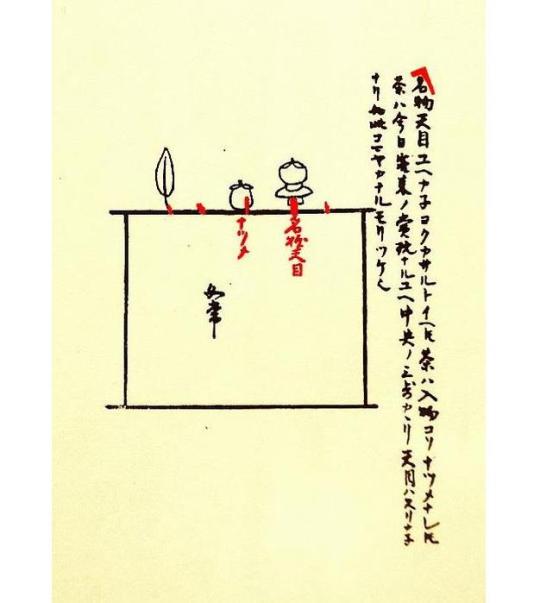
[The writing reads: meibutsu temmoku (名物天目); natsume (ナツメ); jo-jō (如常)³.]
The kaki-ire [書入]⁴:
〇 Because this is a meibutsu temmoku, it should be very carefully displayed on its kane⁵. Nevertheless, even though the tea container is a natsume, because the guests are coming this day to drink the tea [that it contains], in order to show appreciation for the tea, [the natsume] should overlap the center by one-third⁶.
The temmoku should adhere closely to its kane⁷.
[Everything should be done] as is shown, with [exceptional care taken] to each detail when arranging the things [on the ten-ita]⁸.
_________________________
¹The Yakushi-dō temmoku [藥師堂天目] was a Japanese-made white glazed temmoku-chawan, created for Jōō by one of the potters working at the Seto kilns. This was one of several such bowls that were all produced at the same time*.
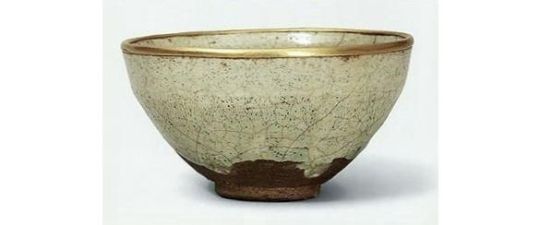

After Jōō’s death, the chawan subsequently known as the Yakushi-dō temmoku came into the possession of the Yaku-in Zensō [施藥院全宗; 1525 ~ 1599]†, originally a monk from Ei-san [叡山] (now known as Hiei-san [比叡山], one of the peaks in the mountain range east of the city between Kyōto and Ōtsu). Apparently on account of his skill in healing, he returned to society (at least to a certain extent -- though he did not forsake his tonsure), and eventually rose to become one of Hideyoshi’s personal attendants. From him this chawan was passed on to Hideyoshi‡.
This temmoku-chawan appears on two occasions in the kaiki that constitutes Book Two of the Nampō Roku**, resting on the Hotta-dai [堀田臺] (which apparently was one of the black lacquered Chinese temmoku-dai known collectively as the kazu-no-dai [數の臺]):
- on the occasion of the first snowfall of the season, when Rikyū served tea to Hideyoshi, Shōrei oshō, Hosokawa Yūsai, and Nambō Sōkei, at dawn (12th day of the Eleventh Month of Tenshō 14 -- December 22, 1586); and,
- on the first day of the First Month of Tenshō 15 (when Rikyū made tea by himself to celebrate the arrival of the New Year, without any guests being present).
This temmoku-chawan is also mentioned several times in other kaiki from the period.
As for why this usage was suppressed, Tanaka Senshō states (I will summarize his words, since his argument is too long and involved to quote in full here): because the Yakushi-dō temmoku was such a peerless bowl†† (the Yamanoue Sōji Ki [山上宗二記] lists it among the three best temmoku‡‡, in its inventory of the famous meibutsu of the second half of the sixteenth century), it would be disrespectful to display it anywhere else but on the central kane. Thus, this arrangement should not be used***.
Be that as it may, the title of this entry shows that the titles -- and probably most of the other things that are written on the sketches -- were added (or at least modified) after Rikyū's death (since his review of this collection of drawings should be dated to 1573 -- the occasion of the first contact between Nambō Sōkei and Rikyū).
___________
*Some sources claim that the bowl shown in the photo is the Yakushi-dō temmoku, while others state that it is one of the other white temmoku that were produced at the same time (while the Yakushi-dō was subsequently lost). The Rikyū Daijiten [利休大事典] quotes the name for the bowl in the photo as Yaku-in [藥院], based on the text of one of Rikyū’s letters (though in his kaiki, Rikyū clearly uses the name Yakushi-dō, suggesting that they may have been different chawan). The several bowls are said to have been virtually identical.
†Yakushi-dō [藥師堂] means a prayer hall (or private oratory) in which an image of the “Buddha of Healing,” Yakushi nyorai [藥師如來] (Bhai��ajyaguru, भैषज्यगुरु) was enshrined. As Yaku-in Zensō was a monk-physician (indeed, he rose to the post of Hideyoshi’s personal physician), it is likely that this epithet can be associated with him -- since it is probable that he had such a shrine erected within his residence.
Zensō probably used this chawan when offering tea to the image of Yakushi nyorai.
‡Perhaps around the middle of the 1580s. Rikyū first mentions the use of this temmoku (when serving tea to Hideyoshi’s guests), in his own kaiki, in 1586.
On the other hand, other accounts state that this bowl passed from Jōō to Hideyoshi (which is unlikely, since Jōō died in 1555, at which time Hideyoshi was a relatively obscure follower of Nobunaga), and then from Hideyoshi to Hidetsugu, and finally to Yakuin Zensō. This denrai [傳來] would not be able to account for the origin of the name Yakushi-dō, however, since the name was being used at least as early as 1586.
It is also possible that Zensō presented this bowl to Hideyoshi, who then returned it to Zensō a decade later (perhaps because the memory of its association with Hidetsugu was offensive to Hideyoshi).
**In the kaiki that was published as Book Six of the Rikyū Chanoyu Sho [利休茶湯書] (1680 -- it was the publication of this collection that sent Tachibana Jitsuzan to the Nanshū-ji, with his request to inspect the documents preserved in the Shū-un-an for himself) -- which covers the period from the autumn of Tenshō 18 (1590) until his death on the 28th day of the Second Month (technically the third month of that year, since Tenshō 19 had two First Months), Rikyū records that he used the Yakushi-dō temmoku during 14 gatherings -- including when he entertained Hideyoshi. This would suggest that this temmoku was closely associated with Rikyū by his contemporaries (at least during this period).
††Tanaka uses the term kakure-naki no meibutsu [隠れなきの名物], which means a meibutsu that is recognized (hence “not hidden,” which is literally what kakure-naki [隠れなき] means) by everyone.
As for what happened to this chawan after Rikyu’s seppuku, the surviving records are unclear. It would probably have been returned to Hideyoshi's collection, of course, but there is no mention of it thereafter. Perhaps it was destroyed during the conflict between the Toyotomi and Tokugawa families at the beginning of the Edo period -- or, perhaps, Hideyoshi returned it to Yaku-in Zensō.
‡‡According to Sōji, “with respect to the temmoku, the temmoku owned by Jōō is one, and the white temmoku is one; among the best three [temmoku] in the world, the Lord Kanpaku [Hideyoshi] has two of them, while the Insetsu no temmoku is owned by the Abura-ya [family] of Sakai” (temmoku no koto Jōō-shoji no temmoku no hito[tsu], haku-temmoku hito[tsu], ten-ka mi[tsu no] uchi futa[tsu] Kanpaku-sama [ni] ari , Insetsu [no] temmoku Sakai Aburaya [ni] ari [天目之事 紹鷗所持之一、白天目一、天下三内二關白樣在、引拙天目堺油屋あり]).
The “Jōō-shoji no temmoku” mentioned by Sōji is identified with the white temmoku shown in the photo by the Tokugawa Bijutsu-kan [徳川美術館] (which, in turn, suggests that both of the bowls owned by Hideyoshi that are mentioned by Sōji were white temmoku). The Tokugawa Bijutsu-kan, in Nagoya, preserves the Tokugawa shōgunate’s collection.
***It is even possible that this sentence was added to the title during the early Edo period, after this chawan came into the possession of the Tokugawa family (assuming that the bowl that is owned by them can be identified with the Yakushi-dō temmoku) -- in order to protect one of their great treasures from the “mundane” usage that this entry prescribes for “ordinary” meibutsu temmoku.
²Meibutsu temmoku kazari nari・Yakushi-dō kaku no gotoki kaburi-kazari nari [名物天目飾也・藥師堂如此被飾也].
“The display of a meibutsu-temmoku. This arrangement has been suppressed for the Yakushi-dō [temmoku].”
³Jo-jō [如常].
“As usual.”
Referring to the utensils arranged on the ji-ita of the daisu.
⁴The Japanese text of the kaki-ire reads:
〇 Meibutsu temmoku yue, kane yoku kazaru to ie-do mo, cha ha iremono-koso natsume nare-do mo, cha ha kyō kyaku-kuru no shōgan nare yue, chū-ō no san-bun kakari, temmoku ha suri-gane nari, kaku no gotoki komayaka-naru mori-tsuke nari
[名物天目ユヘ、カネヨクカサルトイヘトモ、茶ハ入物コソナツメナレトモ、茶ハ今日客來ノ賞玩ナレユヘ、中央の三步カヽリ、天目ハスリカネナリ、如此コマヤカナルモリツケ也].
⁵Meibutsu temmoku yue, kane yoku kazaru to ie-do mo [名物天目ユヘ、カネヨクカサルトイヘトモ].
“Because this is a meibutsu-temmoku, even though we may say that it should be carefully displayed on its kane....”
The expression to ie-do mo [と言えども] means “be that as it may,” or “having said that.” It is intended to introduce an element of doubt (because the temmoku is not displayed on the central kane -- which might strike the reader as difficult to understand).
⁶Cha ha iremono-koso natsume nare-do mo, cha ha kyō kyaku-kuru no shōgan nare yue, chū-ō no san-bun kakari [茶ハ入物コソナツメナレトモ、茶ハ今日客來ノ賞玩ナレユヘ、中央の三步カヽリ].
“Because it is the container for the tea, even if it is a natsume, and because it is the tea that today’s guests are coming to appreciate, [the natsume] should overlap the center by one-third.”
Cha ha iremono-koso [茶は入物こそ] means “because it is the container for the tea....”
Natsume nare-do mo [ナツメ成れども] means “even though it is a natsume.” In other words, even though the tea container is only a natsume....
Cha ha kyō kyaku-kuru no shōgan nare yue [茶は今日客来るの賞玩なれゆえ] means “because the tea is the thing that today’s guests have come to appreciate....”
⁷Temmoku ha suri-gane nari [天目ハスリカネナリ].
“The temmoku should press tightly against its kane.”
Suri-gane [ 摺り矩; 摺り曲尺] is equivalent to the expression mine-suri [峰摺り] that is used more commonly, in instances such as this, in the Nampō Roku.
As has been mentioned before, this is one of a group of machi-shū arrangements that appear to have been added to the collection in the early Edo period, and so the usages conform with the conventions prevalent at that point in history.
⁸Kaku no gotoki komayaka-naru mori-tsuke nari [如此コマヤカナルモリツケ也].
“Just like this, [paying] close attention to the details, [the utensils] should be arranged on [the ten-ita].”
Komayaka-naru [細かなる] means to become small, fine, detailed. In other words, to attend to the details (of the way the things are arranged) carefully.
Mori-tsuke [盛付け] means the way things are arranged -- though it is more commonly used to refer to the way food is arranged on a serving dish, than to utensils on the daisu. (Though this is consistent with Edo period linguistic conventions.)
——————————————–———-—————————————————
◎ Analysis of the Arrangement.
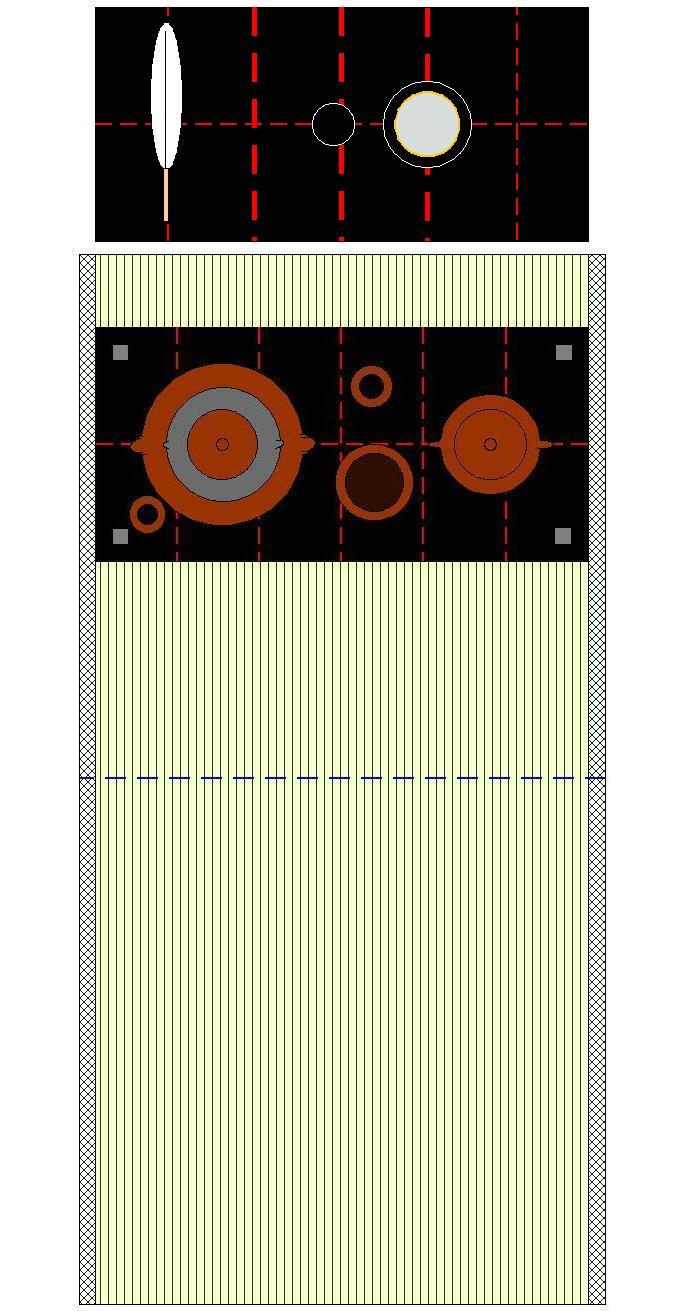
This is the arrangement, as depicted in the sketch that accompanies this entry. It is unclear -- assuming that the objects arranged on the ji-ita are truly “as usual” (meaning the ordinary nanatsu-kazari [七ツ飾] that is shown above) why the habōki should be placed on its kane, since this gives a count of 3 for the ji-ita and 3 for the ten-ita, totaling 6 for the daisu, which is chō [調]. The only thing that can be said is that this is a machi-shū derived temae, which may suggest a certain degree of uncertainty regarding the concept of kane-wari.
Shibayama Fugen’s teihon [底本], however, shows the habōki disassociated from the kane (below), which would result in the preferred count of han [半] for the daisu, which is appropriate for the beginning of the goza during the daytime.
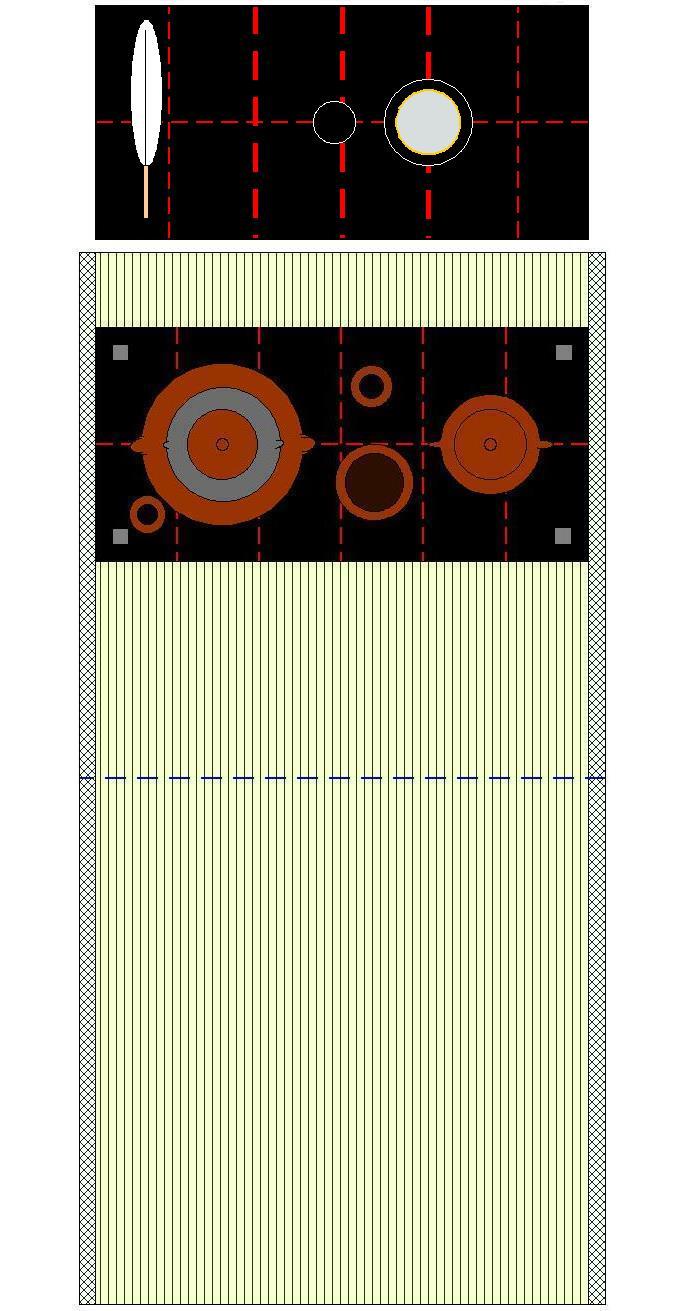
In general, the editor of Shibayama Fugen’s source seems to have made an effort to correct mistakes that crept into Tachibana Jitsuzan’s material (many of which seem to have been due to his attempting to copy things as quickly as possible, with errors sometimes amplified when he interpreted his original, rough sketches, as he was preparing the manuscript that he was planning to present to the Enkaku-ji). We must, of course, remember that this later version was made after intensive discussions had clarified points that Jitsuzan may not have been aware of earlier.
As for the matter of this arrangement being suppressed when a temmoku of the highest rank is being used, at least part of the confusion seems to be based on interpreting things through the modern orientation (which, of course, was the usual way the room was arranged since the beginning of the Edo period), where the guests are seated on the host’s right. We must always keep in mind that in Jōō’s day (and, of course, before), the orientation of the room used for chanoyu mirrored the way that the daisu is arranged before the altar of a Buddhist temple: the daisu was set up in front of the statue of Yakushi nyorai (since the medicine tea, and so chanoyu, are under his protection), who is traditionally located on the Buddha’s left. Thus, the guests (like the image of the Buddha in the temple) were originally supposed to be on the host’s left side.
In the previous entry, a meibutsu chawan (the Shukō-chawan [珠光茶碗]) was oriented on the central kane, while the chaire was placed on the first kane to its right. Here, the natsume is placed on the central kane, while the meibutsu temmoku is arranged as a mine-suri on the first kane to its right. The central kane is, of course, a respected position. But the kane to its right is, in a sense, an even more respected position -- because the object displayed in association with that kane is even farther removed from the part of the room where the guests are seated (in the original orientation), and so even more protected (at the very least, from the dust which the guests may inadvertently stir up as they move around). It is only when the orientation was reversed, at the insistence of Hideyoshi, that now the meibutsu temmoku appears to be closer to the guests when displayed on that kane.
Earlier in Book Five, an ordinary dai-temmoku was displayed on the first kane to the left of the central one, at least when tea would be served to a member of the host’s house, and then the nagabon was moved toward the right, so that the ordinary temmoku was now on the central kane when tea would be served to a guest from a different house. Here, a meibutsu temmoku is moved one kane farther toward the right -- which, in light of the previous arrangements, should be considered the more respected position. And as for the natsume, here the host is charged with balancing the inferiority of the tea container with the importance of the tea it contains (since there is no chanoyu without the tea!).
As has been said before, most of the difficulties regarding the interpretation of the Nampō Roku occur when we try to impose modern conventions on these arrangements from the distant past.
1 note
·
View note
Text
japanese death euphemisms
亡くなる, nakunaru, ”to become no longer there,” to die (the kanji is only used in the context of death afaik but its the same word as 無い - not there or not in existence)
あの世, a no yo, “that world,” the afterlife (あの世に行きました / He passed on to the afterlife / He went to that world)
入れ物, iremono, “something that you put something in,” coffin
1 note
·
View note
Text
19-09-22(sun) 思い出野郎Aチーム presents ウルトラ”フリー”ソウルピクニック@二子玉川ライズ 中央広場
思い出野郎Aチーム
お笑い:ハナコ、Aマッソ、ゼスト、ファイヤーサンダー、TOY
フード&ドリンク:インド富士子×妄想インドカレー ネグラ×ピワン、三月の水、TRESOL、tipi、Mighty steps coffee stop、RUBBER TRUMP
出店:BARBER SAKOTA、BLUE LUG、DESPERATE LIVING、hariknitting、iremono、omeal the kinchaku、PEOPLE BOOKSTORE、softs、猫企画、a.greenpeas、FT2 WORKS、Masayuki Yoshinari、mic、picnic、QUEUE DE RANUN、TAGAKU、ueyama canvas、むらいさき、段々倶楽部

0 notes
Photo
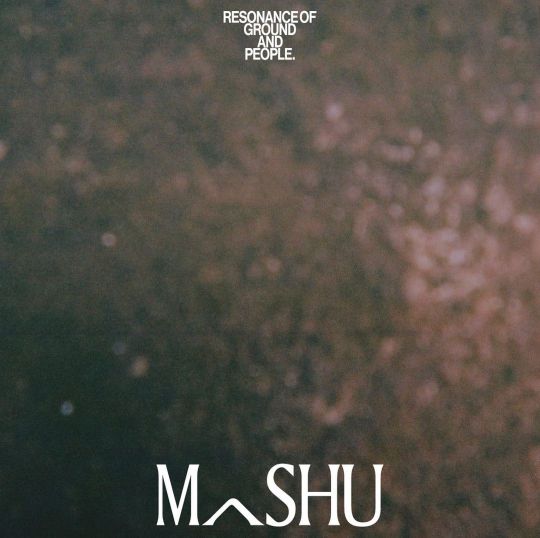
MASHU POPUP 〜Natural Stone〜 2022.12/08(thu)〜12/11(sun) 営業時間:::12:00〜20:00 12/11(sun)のみ〜19:00 在店時間:::15:00〜20:00 12/11(sun)のみ〜19:00 @iremono__ 桜新町 #MASHU #MASHUaccessory #MASHUjewelry #MASHUPOPUP #iremono #桜新町 #sakurashinmachi #サザエさん通り商店街 https://www.instagram.com/p/Cl-fyevy70C/?igshid=NGJjMDIxMWI=
0 notes
Photo

⇩ 2022.12.25.sun wad collection room popup 本日最終日となります。 18時までとなりますがお待ちしております。 当日お持ち帰りいただけます展示販売となっておりますので最終日までよろしくお願いいたします。 (※カラー等で欠品の物は受注となります。) 2022.12.17 sat - 25 sun 12:00 - 19:00 ※最終日のみ18:00まで 会場 wad collection room @wad.collectionroom wad collection room 〒542-0081 大阪市中央区南船場4-9-2桜ビル3F tel 06-4708-3616 http://wad-cafe.com @wadcafe wad + 〒542-0081 大阪市中央区南船場4-9-3東新ビル3F tel 06-4708-3616 http://wad-cafe.com 通常ラインナップに加えて今回のpop up に際し準備させていただいた新作商品、1点ものなどの展示販売もさせていただきますのでお気軽にお越しください。 ⇩ ▫︎ roll wallet ▫︎ replica wallet ▫︎ mini wallet / léger ▫︎ bifold wallet ▫︎ bellows foldwallet ▫︎ card holder ▫︎ meno / miniwallet ▫︎ flat wallet ▫︎ trifold wallet ▫︎ coin wallet ▫︎ box handle clutch ▫︎ ◻︎ ring belt ▫︎ vintage money clip ▫︎ iremono #minimalistic #miniwallet #smallwallet #minimal #minimalism #革 #財布 #革財布 #小さい財布 #ミニ財布 #二つ折り財布 #三つ折り財布 #薄い財布 #軽い財布 #leather #wallet #clutch #leatherbag #小さい財布 #ミニ財布 #chamoto #wad #wadcollectionroom #pottery #ceramics #器 #うつわ #古物 https://www.instagram.com/p/Cmk03knvkJg/?igshid=NGJjMDIxMWI=
#minimalistic#miniwallet#smallwallet#minimal#minimalism#革#財布#革財布#小さい財布#ミニ財布#二つ折り財布#三つ折り財布#薄い財布#軽い財布#leather#wallet#clutch#leatherbag#chamoto#wad#wadcollectionroom#pottery#ceramics#器#うつわ#古物
1 note
·
View note
Text
Yorushika – Shisouhan - Lyrics
Yorushika – Shisouhan - Lyrics
Yorushika – Shisouhan (Thought Crime) Lyrics English Translation
Download Mp3 :- Link
Romaji
hito ni yasashii anta ni kono kokoro ga wakaru mono ka
hito wo norou no ga kokochi ii, dakara uta wo kaiteita
asa no houdou nyuusu ni itsuka noru koto ga yume datta
sono tame ni houchou wo toideru
garasu wo tatakitsukeru oto, nanika no kami wo yabuku koto,
sayonara no ato no yuuhi ga utsukushii tte, kimi datte wakaru daro
karasu no uta ni akane
kono kodoku mo ima oto ni kawaru
omokage ni sashita higure
tsumasakidatsu, kumo ga yakeru, sayonara ga kuchi wo suberu
mitomeraretai, aishitai
kore ga yume tte yatsu ka
nanimo shinakutemo kanaeyo, hayaku, boku wo mitashite kure
hito ni yasashii seken ni kono netami ga wakaru mono ka
itsumo dareka wo nagureru kikai wo sagashiteru
biiru bin de naguru gairotou, nageru gitaa no oreru oto,
modoranai koukai no zenbu ga utsukushii tte, sou iu no saa, boku datte wakaru no ni
kotoba no ame ni utare
aki oshimu mama fuyu ni ochiru
haru no yama no ushiro kara mata hitotsu kemuri ga tatsu
natsukaze ga hoho wo suberu
hito ni yasashii anta ni kono kodoku ga wakaru mono ka
shinitakunai ga ikirarenai, dakara uta wo kaiteiru
batou mo shitsubou mo keno mo boku e no kyoumi da to omou kara
hito wo kizutsukeru uta wo kaiteru
konna nakami no nai uta wo kaiteru
kimi no kotoba ga nomitai
iremono mo nai ryoute de ukete
itsu shika nodo ga uruou
sono toki wo machi nagara
karasu no uta ni akane
kono kodoku yo ima uta ni kaware
sayonara, kimi ni akane
boku wa ima, yoru wo matsu
mata ashita. kuchi ga suberu
English
Are you kind to others, can you understand this heart?
I’m writing poems because it’s nice to curse people
It was my dream to appear in the morning news report one day
For that, sharpen the knife
The sound of hitting glass, breaking some paper,
You know that the setting sun after goodbye is beautiful
Akane in a crow song
This loneliness now turns into sound
The nightfall
Standing toe, burning clouds, goodbye slippery
I want to be recognized, I want to love
This is my dream
Give me nothing, do it fast, fill me
Do you understand this envy in a world that is kind to others?
I’m always looking for an opportunity to hit someone
Street light hitting with a beer bottle, the sound of a broken guitar thrown,
All the regrets that I can’t return to are so beautiful, even I understand
Struck by the rain of words
Fall in winter with regret
There is another smoke from behind the mountain in spring
Summer breeze slips on the cheek
Do you know this loneliness that is kind to others?
I don’t want to die but I can’t live, so I’m writing poems
I think abusiveness, disappointment, and disgust are my interests
I’m writing poems that hurt others
I’m writing such an empty poem
Your words are like drinking
Receive with both hands without a container
Someday my throat gets moist
Waiting for that time
Akane in a crow song
This loneliness is now transformed into poetry
Goodbye to you Akane
I wait for the night now
see you tomorrow. Mouth slips
youtube
https://bit.ly/2Yy4JP3 from Blogger https://bit.ly/3hYXlUu
0 notes
Photo
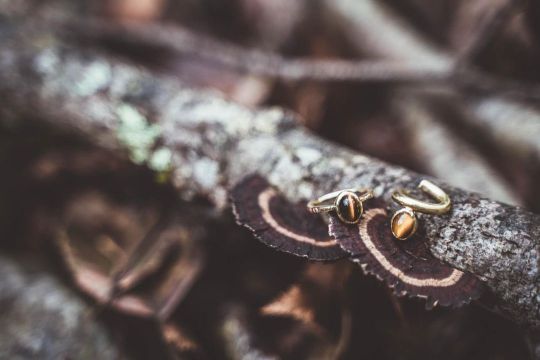
RESONANCE OF GROUND AND PEOPLE. Tiger eye brass ring Tiger eye brass ear cuff At Tanzawa Photo::: @namasayaio MASHU POPUP 〜Natural Stone〜 2022.12/08(thu)〜12/11(sun) 営業時間:::12:00〜20:00 12/11(sun)のみ〜19:00 在店時間:::15:00〜20:00 12/11(sun)のみ〜19:00 @iremono__ 桜新町 #MASHU #MASHUaccessory #MASHUjewelry #MASHUPOPUP #iremono #桜新町 #sakurashinmachi #サザエさん通り商店街 この商品は12/8〜12/11までの @iremono__ での MASHU POPUPにて販売中です。 (iremono) https://www.instagram.com/p/Cl-frt8SNNV/?igshid=NGJjMDIxMWI=
0 notes
